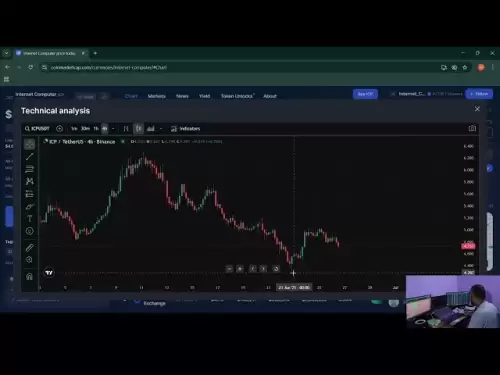-
 Bitcoin
Bitcoin $107,247.2038
-0.18% -
 Ethereum
Ethereum $2,424.7947
0.34% -
 Tether USDt
Tether USDt $1.0003
-0.02% -
 XRP
XRP $2.1171
-3.33% -
 BNB
BNB $645.6618
0.06% -
 Solana
Solana $141.5898
-1.32% -
 USDC
USDC $0.9998
0.00% -
 TRON
TRON $0.2710
-0.41% -
 Dogecoin
Dogecoin $0.1602
-2.99% -
 Cardano
Cardano $0.5553
-2.28% -
 Hyperliquid
Hyperliquid $36.3019
-2.42% -
 Bitcoin Cash
Bitcoin Cash $491.7212
2.04% -
 Chainlink
Chainlink $13.0810
-0.23% -
 Sui
Sui $2.6080
-5.06% -
 UNUS SED LEO
UNUS SED LEO $9.0040
-0.05% -
 Stellar
Stellar $0.2350
-3.06% -
 Avalanche
Avalanche $17.2294
-2.31% -
 Toncoin
Toncoin $2.8075
-1.05% -
 Shiba Inu
Shiba Inu $0.0...01121
-3.43% -
 Litecoin
Litecoin $84.2215
-0.32% -
 Hedera
Hedera $0.1429
-4.88% -
 Monero
Monero $312.2199
-0.90% -
 Dai
Dai $0.9997
-0.01% -
 Ethena USDe
Ethena USDe $0.9999
-0.02% -
 Polkadot
Polkadot $3.2973
-2.60% -
 Bitget Token
Bitget Token $4.4742
3.12% -
 Pi
Pi $0.5631
-10.10% -
 Uniswap
Uniswap $6.7817
-2.06% -
 Pepe
Pepe $0.0...09252
-3.74% -
 Aave
Aave $251.3830
-2.24%
How to make money on currency exchanges
To capitalize on the cryptocurrency market, select a reputable exchange, fund your account, identify profitable trades, place orders strategically, monitor market dynamics, and either withdraw profits or reinvest for potential gains.
Jan 11, 2025 at 07:48 am

Key Points
- Choose a reputable and secure cryptocurrency exchange.
- Create an account and fund it with fiat currency or other cryptocurrencies.
- Select the cryptocurrency you want to trade.
- Place a buy or sell order at the desired price.
- Monitor the market and adjust your orders as needed.
- Withdraw your profits or reinvest them in other cryptocurrencies.
How to Make Money on Currency Exchanges
1. Choose a Reputable and Secure Cryptocurrency Exchange
The first step to making money on currency exchanges is to choose a reputable and secure exchange. There are many different cryptocurrency exchanges available, each with its unique features and fees. Some of the most popular exchanges include Coinbase, Binance, and Kraken.
When choosing an exchange, it is important to consider the following factors:
- Security: The exchange should have a strong security record and use industry-leading security measures to protect your funds.
- Fees: The exchange should have competitive fees that are clearly outlined.
- Ease of use: The exchange should have an easy-to-use interface that makes it easy to buy, sell, and trade cryptocurrencies.
- Customer support: The exchange should have responsive customer support that can help you with any issues you may encounter.
2. Create an Account and Fund It
Once you have chosen an exchange, you need to create an account. This usually involves providing your name, email address, and phone number. You may also need to provide proof of identity, such as a driver's license or passport.
Once you have created an account, you need to fund it with fiat currency or other cryptocurrencies. You can do this by linking your bank account or by depositing cryptocurrencies from another wallet.
3. Select the Cryptocurrency You Want to Trade
There are thousands of different cryptocurrencies available, each with its unique price and volatility. When choosing a cryptocurrency to trade, it is important to consider the following factors:
- Market capitalization: The market capitalization of a cryptocurrency is the total value of all its outstanding coins. The higher the market capitalization, the more stable the cryptocurrency is likely to be.
- Trading volume: The trading volume of a cryptocurrency is the number of coins that are traded each day. The higher the trading volume, the more liquid the cryptocurrency is and the easier it is to buy and sell.
- Volatility: The volatility of a cryptocurrency is the extent to which its price fluctuates. The more volatile a cryptocurrency is, the greater the potential for profit but also the greater the risk of loss.
4. Place a Buy or Sell Order
Once you have selected a cryptocurrency to trade, you need to place a buy or sell order. A buy order is an order to purchase a cryptocurrency at a specified price. A sell order is an order to sell a cryptocurrency at a specified price.
When placing an order, you need to specify the following:
- The type of order: There are different types of orders available, such as market orders, limit orders, and stop orders. Each type of order has its own advantages and disadvantages.
- The price: You need to specify the price at which you want to buy or sell the cryptocurrency.
- The quantity: You need to specify the number of coins that you want to buy or sell.
5. Monitor the Market and Adjust Your Orders
The cryptocurrency market is constantly moving, so it is important to monitor the market and adjust your orders as needed. If the price of a cryptocurrency moves in your favor, you may want to sell your coins for a profit. If the price moves against you, you may want to buy more coins at a lower price.
6. Withdraw Your Profits or Reinvest Them
Once you have made a profit, you can withdraw your funds or reinvest them in other cryptocurrencies. To withdraw your funds, you simply need to send them to a cryptocurrency wallet. To reinvest your profits, you simply need to place a buy order for another cryptocurrency.
FAQs
- What is the best cryptocurrency exchange?
There is no one-size-fits-all answer to this question. The best cryptocurrency exchange for you will depend on your individual needs and preferences. However, some of the most popular and well-respected exchanges include Coinbase, Binance, and Kraken.
- How much money can I make on a currency exchange?
The amount of money you can make on a currency exchange depends on a number of factors, such as the volatility of the cryptocurrency market, your trading strategy, and your skill level. However, it is possible to make a significant profit by trading cryptocurrencies.
- Is it risky to trade cryptocurrencies?
Yes, it is risky to trade cryptocurrencies. The cryptocurrency market is highly volatile and prices can fluctuate rapidly. However, the potential rewards of trading cryptocurrencies can be significant.
- How can I reduce the risk of trading cryptocurrencies?
There are a number of ways to reduce the risk of trading cryptocurrencies, such as:
* **Only trade with money that you can afford to lose.**
* **Do your research and understand the risks involved.**
* **Use a stop-loss order to limit your losses.**
* **Diversify your portfolio by investing in multiple cryptocurrencies.**Disclaimer:info@kdj.com
The information provided is not trading advice. kdj.com does not assume any responsibility for any investments made based on the information provided in this article. Cryptocurrencies are highly volatile and it is highly recommended that you invest with caution after thorough research!
If you believe that the content used on this website infringes your copyright, please contact us immediately (info@kdj.com) and we will delete it promptly.
- Crypto Presales in 2025: MAGACOIN FINANCE and the Hunt for New Coins
- 2025-06-27 04:50:12
- Bitcoin's Next Leap: Will It Hit a New All-Time High with Michaël van de Poppe's Prediction?
- 2025-06-27 05:50:12
- Litecoin Mining in 2025: Rigs, Returns, and the Rise of Cloud Mining
- 2025-06-27 05:10:12
- LINK's Holder Count Soars as ATH Predictions Heat Up: What's Next?
- 2025-06-27 05:30:12
- Dogecoin, Meme Coins, and Price Predictions: What's the Hype?
- 2025-06-27 05:50:12
- Senate, Bitcoin, and the Reserve: What's the Deal?
- 2025-06-27 04:30:12
Related knowledge
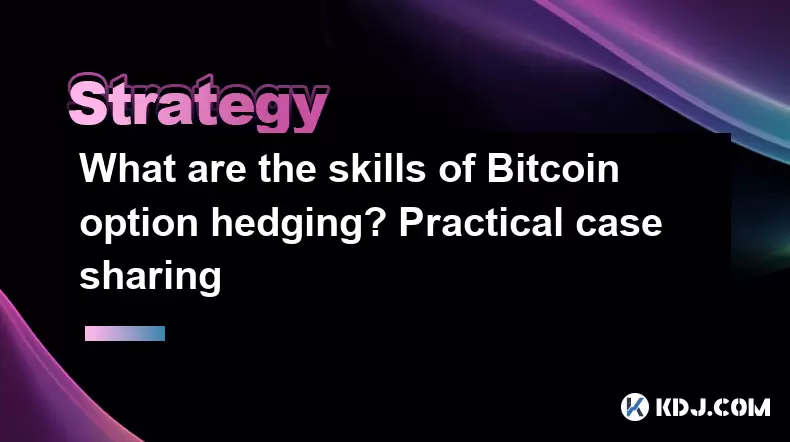
What are the skills of Bitcoin option hedging? Practical case sharing
Jun 24,2025 at 04:01pm
Understanding Bitcoin Option HedgingBitcoin option hedging is a risk management strategy used by traders and investors to protect their positions in the volatile cryptocurrency market. By using options, individuals can limit potential losses while retaining the opportunity for profit. In essence, it allows one to insulate against adverse price movements...
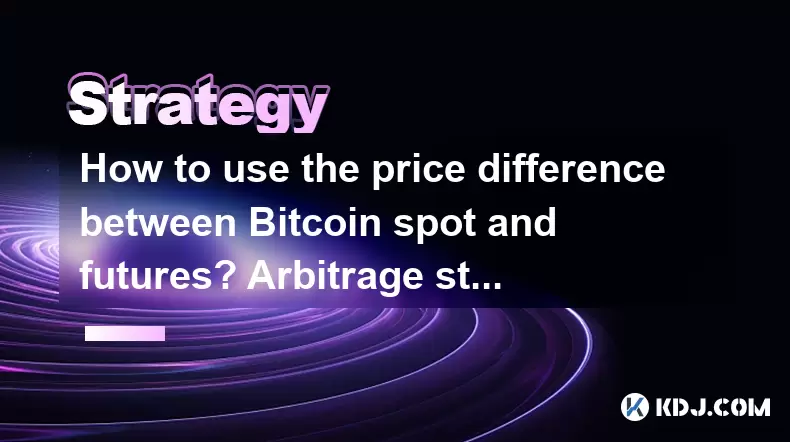
How to use the price difference between Bitcoin spot and futures? Arbitrage strategy
Jun 20,2025 at 02:56pm
Understanding Bitcoin Spot and Futures MarketsTo effectively leverage arbitrage opportunities between Bitcoin spot and futures markets, it's essential to understand the fundamental differences between these two types of markets. The spot market refers to the direct buying and selling of Bitcoin for immediate delivery at the current market price. In cont...
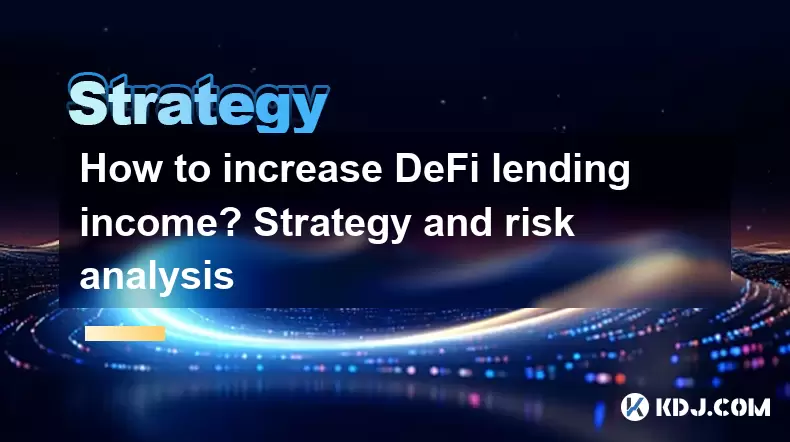
How to increase DeFi lending income? Strategy and risk analysis
Jun 24,2025 at 02:08pm
Understanding DeFi Lending and Its Income PotentialDeFi (Decentralized Finance) lending has emerged as a popular way to earn passive income in the cryptocurrency space. Unlike traditional banking systems, DeFi lending platforms allow users to lend their crypto assets directly to borrowers without intermediaries. The lenders earn interest based on the su...
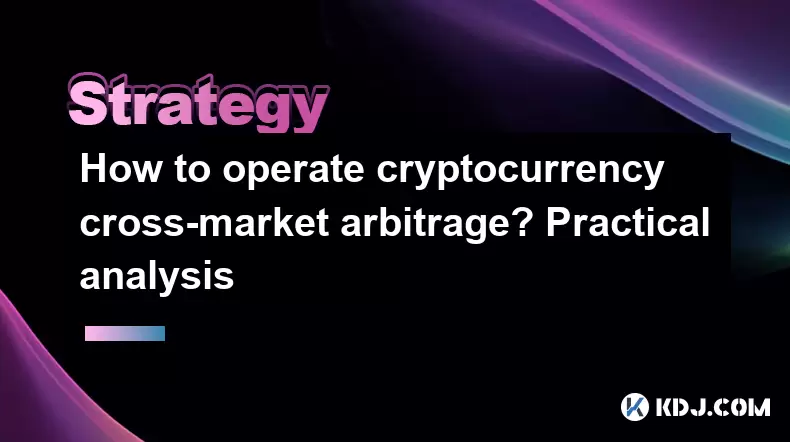
How to operate cryptocurrency cross-market arbitrage? Practical analysis
Jun 23,2025 at 04:01am
Understanding Cryptocurrency Cross-Market ArbitrageCryptocurrency cross-market arbitrage involves taking advantage of price differences for the same digital asset across different exchanges. The core idea is to buy low on one exchange and sell high on another, capturing the profit from the discrepancy. This strategy relies heavily on real-time market da...

How to make profits from high-frequency cryptocurrency trading? Sharing core skills
Jun 19,2025 at 05:07pm
Understanding High-Frequency Cryptocurrency TradingHigh-frequency trading (HFT) in the cryptocurrency market involves executing a large number of trades at extremely fast speeds, often within milliseconds. This method relies on small price discrepancies across exchanges or within a single exchange’s order book. Traders use complex algorithms and ultra-l...

What are the methods of cryptocurrency quantitative trading? Detailed analysis
Jun 22,2025 at 11:07pm
Understanding the Core of Cryptocurrency Quantitative TradingCryptocurrency quantitative trading refers to the use of mathematical models and algorithms to execute trades in the digital asset market. Unlike traditional discretionary trading, which relies heavily on human judgment, quantitative trading leverages data-driven strategies to identify profita...

What are the skills of Bitcoin option hedging? Practical case sharing
Jun 24,2025 at 04:01pm
Understanding Bitcoin Option HedgingBitcoin option hedging is a risk management strategy used by traders and investors to protect their positions in the volatile cryptocurrency market. By using options, individuals can limit potential losses while retaining the opportunity for profit. In essence, it allows one to insulate against adverse price movements...

How to use the price difference between Bitcoin spot and futures? Arbitrage strategy
Jun 20,2025 at 02:56pm
Understanding Bitcoin Spot and Futures MarketsTo effectively leverage arbitrage opportunities between Bitcoin spot and futures markets, it's essential to understand the fundamental differences between these two types of markets. The spot market refers to the direct buying and selling of Bitcoin for immediate delivery at the current market price. In cont...

How to increase DeFi lending income? Strategy and risk analysis
Jun 24,2025 at 02:08pm
Understanding DeFi Lending and Its Income PotentialDeFi (Decentralized Finance) lending has emerged as a popular way to earn passive income in the cryptocurrency space. Unlike traditional banking systems, DeFi lending platforms allow users to lend their crypto assets directly to borrowers without intermediaries. The lenders earn interest based on the su...

How to operate cryptocurrency cross-market arbitrage? Practical analysis
Jun 23,2025 at 04:01am
Understanding Cryptocurrency Cross-Market ArbitrageCryptocurrency cross-market arbitrage involves taking advantage of price differences for the same digital asset across different exchanges. The core idea is to buy low on one exchange and sell high on another, capturing the profit from the discrepancy. This strategy relies heavily on real-time market da...

How to make profits from high-frequency cryptocurrency trading? Sharing core skills
Jun 19,2025 at 05:07pm
Understanding High-Frequency Cryptocurrency TradingHigh-frequency trading (HFT) in the cryptocurrency market involves executing a large number of trades at extremely fast speeds, often within milliseconds. This method relies on small price discrepancies across exchanges or within a single exchange’s order book. Traders use complex algorithms and ultra-l...

What are the methods of cryptocurrency quantitative trading? Detailed analysis
Jun 22,2025 at 11:07pm
Understanding the Core of Cryptocurrency Quantitative TradingCryptocurrency quantitative trading refers to the use of mathematical models and algorithms to execute trades in the digital asset market. Unlike traditional discretionary trading, which relies heavily on human judgment, quantitative trading leverages data-driven strategies to identify profita...
See all articles
























